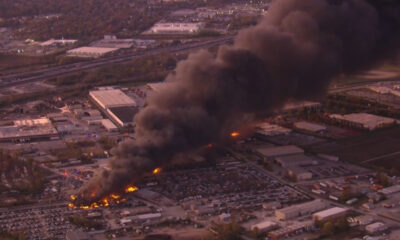Reviews
How Contractor Management Systems Improve Lone Worker Safety

Contractors often work in isolated environments where immediate support is limited. Lone workers face unique risks that require stronger safety measures. Contractor management systems provide practical solutions to monitor, train and protect these workers. By combining technology with clear safety processes, organisations can reduce risks, improve compliance and ensure contractors return home safely.
Understanding Lone Worker Risks
Lone working means carrying out tasks without direct supervision or support. These roles can be found across construction, maintenance, security and utilities. Without colleagues nearby, workers may struggle to get help in an emergency or face hazards without assistance.
Physical Risks
Accidents involving equipment, slips, trips or falls present serious challenges. If a lone worker suffers an injury, the delay in receiving help can make the outcome worse. Working with dangerous machinery or in remote locations increases the chance of incidents that require immediate response.
Health and Wellbeing Risks
Beyond physical hazards, lone workers are exposed to health risks linked to isolation. Stress, fatigue or medical emergencies may go unnoticed until it is too late. Limited communication with supervisors can also make it difficult to raise concerns or report unsafe conditions. These risks highlight the need for systems that improve visibility and control.
What Is a Contractor Management System?
A contractor management system is a platform that helps organisations control how contractors are selected, trained and monitored. It sets clear rules for safety checks and ensures compliance with legal duties.
Online contractor management software allows businesses to centralise contractor data, manage permits and confirm that safety requirements are met before work begins. These systems reduce paperwork while providing managers with real-time oversight.
Key Features That Support Lone Worker Safety
Contractor management systems provide a set of tools designed to protect contractors who work without direct supervision.
Real-Time Monitoring and Check-Ins
Modern systems include GPS tracking and automated check-in processes. These functions allow managers to see where lone workers are located and confirm that they are safe. If a worker fails to check in, the system sends alerts to supervisors so help can be dispatched quickly.
Risk Assessment and Permit Controls
Before work begins, risk assessments must be carried out to identify potential hazards. Contractor management systems record and verify these assessments. Permit-to-work controls are also built in, ensuring that no task starts without proper authorisation. This process reduces the likelihood of unsafe work being carried out.
Training and Competency Verification
A contractor’s qualifications and training record must be checked before they begin work. Systems provide a central database where this information is stored and verified. Tracking lone worker training records helps confirm that individuals have completed the necessary safety courses.
Communication Tools
Communication is essential for lone worker safety. Contractor management systems often include messaging functions, panic buttons and alert systems. These features allow workers to raise concerns or request help without delay. Managers can also use these tools to send reminders about safety checks or emergency procedures.
How Contractor Management Systems Improve Safety Outcomes
Contractor management systems have a direct impact on reducing risks for lone workers. Their functions create safer environments and support quick intervention when needed.
Faster Emergency Response
When incidents occur, time is critical. Systems equipped with alerts and monitoring tools allow managers to respond immediately. Automated notifications ensure supervisors know the worker’s exact location and condition, reducing delays that could worsen the outcome.
Reduced Human Error
Human error often arises from missed steps, incomplete documentation or forgotten safety checks. Automated workflows minimise these risks. For example, a system may block access to a task until a risk assessment is complete, preventing unsafe practices. This process helps standardise safety routines and lowers the chance of mistakes.
Better Compliance with UK Regulations
The Health and Safety Executive (HSE) requires employers to assess and control risks for lone workers. Contractor management systems provide a clear audit trail that proves compliance. By recording risk assessments, training and permits, organisations show regulators they are meeting their legal responsibilities. This reduces the risk of penalties while improving overall safety culture.
Practical Benefits for Employers
Improving lone worker safety benefits more than just the individual worker. Organisations also see gains in cost management, oversight and reputation.
Cost Savings Through Prevention
Workplace incidents can lead to high medical costs, lost productivity and increased insurance premiums. Preventing accidents through structured monitoring reduces these costs. Investment in a system can therefore save money in the long term while protecting staff.
Improved Contractor Oversight
Contractors often move between different worksites, which makes tracking activity difficult. A centralised system allows managers to view all contractor tasks in one place. This visibility helps ensure that work is completed safely and according to schedule.
Strengthened Reputation
Clients expect contractors to work safely and comply with regulations. Companies that manage lone worker risks effectively build trust with stakeholders. A strong safety record demonstrates professionalism and makes businesses more competitive in winning contracts.
Implementing a Contractor Management System
Adopting a contractor management system requires planning and clear communication. The process involves reviewing current practices, selecting the right technology and ensuring staff know how to use it.
Assess Current Gaps
Before investing in a new system, organisations should identify weaknesses in their existing lone worker processes. This includes reviewing how risk assessments are handled, how training is tracked and how incidents are reported.
Select Suitable Technology
Not all systems offer the same functions. Employers should choose one that matches their industry and level of risk. For example, high-risk environments may need real-time monitoring and location tracking, while lower-risk industries may focus more on training verification and documentation.
Train Staff and Contractors
A system only works if people use it correctly. Staff and contractors must be trained to understand its functions and their responsibilities. Ongoing refresher sessions ensure that users remain confident and committed to safety processes.
Monitor and Review Effectiveness
Implementation does not end once the system is in place. Organisations should track performance data, such as the number of incidents prevented or the speed of emergency responses. Regular reviews help identify areas for improvement and confirm that the system is delivering value.
Safety Without Compromise
Protecting lone workers requires more than policies on paper. Contractor management systems give employers the tools to enforce safety in real time. They provide monitoring, training verification, communication and compliance functions that reduce risks and improve outcomes.
For employers, the benefits extend beyond safety to include cost savings, stronger oversight and enhanced credibility. For workers, these systems mean greater assurance that someone is monitoring their safety and ready to respond when needed.

-

 Breaking News1 week ago
Breaking News1 week agoAt least 3 dead, 11 injured after UPS cargo plane crashes near Louisville airport
-

 Politics4 days ago
Politics4 days agoSenate reaches deal to end record shutdown – CNN
-

 US News1 week ago
US News1 week ago5 firefighters injured in vehicle explosion in the Bronx, NYC
-

 World12 hours ago
World12 hours agoU.S. begins Operation Southern Spear against “narco-terrorists” in the Western Hemisphere
-

 US News1 week ago
US News1 week agoFAA orders 10% flight cut at 40 U.S. markets as shutdown strains air traffic system
-

 World2 days ago
World2 days agoNationwide power outage hits Dominican Republic
-

 US News1 week ago
US News1 week agoDeath toll rises to 11 after UPS cargo plane crash in Louisville
-

 Politics1 week ago
Politics1 week agoForeign hackers breach U.S. Congressional Budget Office – WaPo




